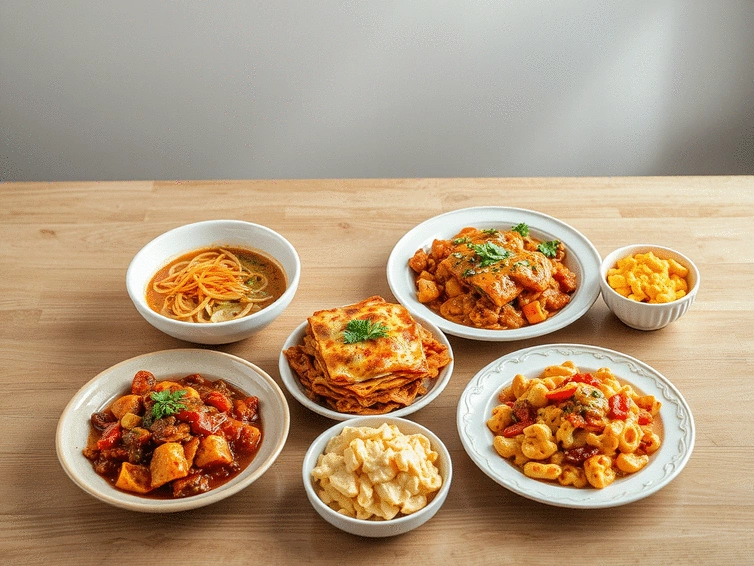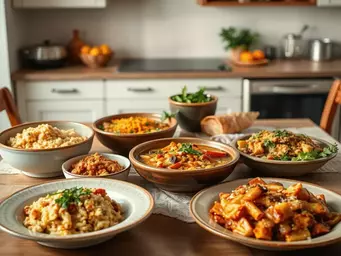Emotional Connection
Dishes evoking memories of family, celebrations, and cozy evenings.

What if your favorite dish is more than just food? It's a key to a treasure chest of memories, emotions, and traditions. Comfort food is a universal concept that transcends borders and cultures, connecting us through shared experiences and flavors. Let's dive into the essence of comfort food and what it reveals about our culinary heritage!
Each comfort food evokes memories and connection, rooted in three fundamental pillars. Discover how these elements intertwine to define what makes a dish truly comforting.
Dishes evoking memories of family, celebrations, and cozy evenings.
Historical importance, customs, and traditions woven into every recipe.
Well-known dishes, often passed down through generations within communities.
Rich, hearty flavors that satisfy the palate and provide soulful comfort.
When we talk about comfort food, we're diving into a world where flavors meet memories, and dishes become a warm hug on a plate. Comfort food varies widely across cultures, but one thing is universal: it brings joy. Each region has its own unique take on what makes a dish comforting, whether it's the spices of a curry or the simplicity of a bowl of mashed potatoes. These foods often tell a story, reflecting the customs and traditions of the people who love them.
In essence, comfort food is a personal experience. It’s about the emotional connections we have with specific ingredients and recipes. For many of us, a particular dish can transport us back to our childhood kitchens, filled with the scents of home-cooked meals. So, what defines comfort food across cultures? Let’s explore!
Comfort food can be defined as the dishes that provide a sense of well-being and nostalgia. It’s fascinating to see how different cultures embrace their comfort foods. Here are a few key elements that typically define these beloved dishes:
As I create and explore recipes for Sloppedia, I’m constantly amazed by the stories behind these dishes. They not only fill our stomachs but also connect us to our roots and each other.

Nostalgia plays a pivotal role in our comfort food choices. Think about your favorite dish—chances are, it’s tied to a memory. Perhaps it was your grandmother's famous lasagna shared during family get-togethers or the mac and cheese that got you through college cramming sessions. These memories shape our preferences and create a sense of belonging.
Why do we gravitate towards certain flavors? Here are a few reasons:
At Sloppedia, I encourage you to reflect on your own comfort food stories. What dishes have shaped your culinary journey? Let's celebrate those flavors together!
Now that we’ve laid the groundwork for understanding comfort food, let’s take a delicious journey through different regions of the world. Each area has its distinctive flavors and cooking styles that contribute to the rich tapestry of comfort foods. Ready to explore?
Did you know? The power of comfort food lies not just in its taste, but also in the stories behind it. When sharing your favorite recipes, take a moment to recount the memories associated with each dish. Whether it's the laughter of family gatherings or the warmth of a grandmother's kitchen, these narratives enhance the dining experience and strengthen connections.
Understanding the cultural significance of comfort foods is essential for appreciating the rich tapestry of culinary traditions around the world. Each dish carries not just flavors but also stories that connect us to our roots and to one another. This journey through comfort foods allows us to recognize our similarities and celebrate our differences.
Whether it’s a hearty bowl of ramen in Japan or a plate of fried chicken in the South, comfort foods remind us of home, family, and the moments we cherish. By exploring these dishes, we deepen our connection to cultures that might otherwise feel distant.
When we dive into the world of comfort food, it's crucial to appreciate the cultural context behind each recipe. Dishes often reflect a region's history, climate, and available ingredients. For instance, a spicy mole from Mexico showcases indigenous ingredients and influences, while a traditional Italian risotto highlights local rice varieties and cooking techniques.
By paying attention to these cultural narratives, we can elevate our cooking and sharing practices. At Sloppedia, we celebrate these stories, encouraging you to explore the delicious threads that weave through our culinary heritage.

Sharing comfort food recipes is a powerful way to connect with others and preserve our culinary heritage. Each recipe often comes with a story that reveals cherished memories, family gatherings, and the love that goes into creating these meals. I encourage you to dig into your own family history and share those treasured recipes!
When we share these dishes, we not only enjoy the flavors but also create spaces for stories, laughter, and connection. It’s a beautiful way to keep our culinary traditions alive, and at Sloppedia, we want to be part of your journey in exploring and sharing these delightful recipes!
Community recipes hold a special place in our hearts and kitchens. They often serve as a reminder of where we come from and help us stay connected to our roots. Many of us have a beloved family recipe that has been passed down through generations, and sharing it can be a way to honor those who came before us.
By celebrating these community traditions, we foster a sense of belonging and create lasting memories. At Sloppedia, we invite you to share your favorite community recipes with us and help build a collective culinary library that honors our diverse backgrounds. For more insights into the broader impact of food on well-being and community, you might find this research on culinary traditions particularly interesting.
Here is a quick recap of the important points discussed in the article:
Global Comfort Foods You’ll Love

Did you know that comfort food often serves as a bridge to our cultural roots? It’s not just about
Exploring Comfort Food Datasets

Have you ever wondered why certain foods feel like a warm embrace on a cold day? Comfort foods are n
Global Comfort Foods You’ll Love
Global Comfort Foods to Savor
Exploring Comfort Food Datasets
Finding Comfort Food for You
Messy Comfort Dishes to Enjoy